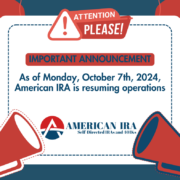Do’s and Don’t’s of Real Estate IRAs
 Ever wonder what you could do with the considerable power of a Self-Directed IRA at your fingertips? Well, if you’ve been reading this site, you know that there are plenty of options available to you. And one of the most tantalizing options is that of Real Estate IRAs.
Ever wonder what you could do with the considerable power of a Self-Directed IRA at your fingertips? Well, if you’ve been reading this site, you know that there are plenty of options available to you. And one of the most tantalizing options is that of Real Estate IRAs.
Real Estate IRAs are retirement accounts in which you invest in a range of real estate properties—and, as you’ll see, these particular brands of retirement accounts come with some pretty tantalizing advantages indeed.
Of course, getting the most from Real Estate IRAs requires that you know what you’re doing. So instead of crafting a long tutorial, we thought that a better introduction to this type of IRA might actually be a “do’s and don’ts” in which we explain the basics. You might know real estate well, but when it comes to putting real estate within an IRA, the rules are tweaked a little bit; you’ll want to know and master them all in order to get the most value for your investment.
Do: Consider a wide range of real estate investment types.
Real estate investments within a Real Estate IRA can include just about anything you can think of, from raw land to commercial property. Apartment buildings, single family homes, townhomes, condominiums—they all fall under the range of possibilities here. There’s no reason to limit yourself when it comes to Real Estate IRAs because you’re allowed to select from a broad range from investments so that you can pick the investments that best represent the most ideal opportunities in your current situation.
Don’t: Think that Real Estate IRAs are going to fix your problems overnight.
Real estate is like many investments; it requires time to grow if you’re going to realize its full potential. There’s the temptation amongst new real estate investors to view real estate as this different type of investment, one that will automatically generate massive amounts of wealth for you in a short amount of time. Of course, that’s not the way the world works. There are risks involved in real estate as there are involved in any type of investment—so take a long-term approach. After all, it is still an IRA we’re talking about here.
Do: Apply leverage within a Real Estate IRA when necessary.
One of the number one questions people have about Real Estate IRAs is whether or not they’re able to use leverage in an IRA—after all, it’s difficult for many people to acquire real estate without some degree of leverage. The fact is, you can indeed use debt to finance property within an IRA, although it’s subject to restrictions. For example, all loans in your IRA must be non-recourse, which means that in the event of a default, the lender can only claim the property for which it has loaned to your IRA. This can sometimes restrict the loan terms.
[tweetthis twitter_handles=”@iraexpert” hidden_hashtags=”#RealEstateIRA”]No reason to limit yourself…with Real Estate IRAs you’re allowed…[/tweetthis]
Don’t: Personally use properties within Real Estate IRAs.
You are not allowed to own assets in your IRA that are for your personal use—and that means not even staying overnight in your property. So ditch any illusions about having a “second or third home” simply because you own property within a Real Estate IRA; it’s simply not allowed.
There are plenty of advantages and disadvantages to this type of account, just as there are in any type of IRA account. But we think you’ll agree that the protections and freedoms afforded to you by Real Estate IRAs certainly makes them worth considering. Call us at 1-866-7500-IRA(472) or continue browsing our site to learn all about real estate as an investment within Self-Directed IRAs.
Images by: presentermedia.com


